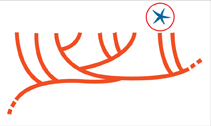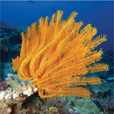Echinoderms

KEY CHARACTERISTICS
Echinoderms are marine animals that have spiny skin surrounding an endoskeleton. Their unique water vascular system includes tube feet with suction-cuplike ends used in moving and feeding. The water vascular system also plays a role in respiration, circulation, and excretion. Echinoderms are coelomate deuterostomes. Adults exhibit 5-part radial symmetry.
Feeding and Digestion Method varies by group—echinoderms can be filter feeders, detritivores, herbivores, or carnivores.
Circulation Via fluid in the coelom, a rudimentary system of vessels, and the water vascular system
Respiration Gas exchange is carried out by surfaces of tube feet, and, in many species, by skin gills.
Excretion Digestive wastes released through anus; nitrogenous cellular wastes excreted as ammonia through tube feet and skin gills.
Response Minimal nervous system; nerve ring is connected to body sections by radial nerves; most have scattered sensory cells that detect light, gravity, and chemicals secreted by prey.
Movement In most, tube feet work with endoskeleton to enable locomotion.
Reproduction Sexual, with external fertilization; larvae have bilateral symmetry, unlike adults.

You can't miss the 5-part radial symmetry of this red mesh sea star moving across a coral reef.
• A Closer Look

Crinoid fossil, about 400 million years old

Living modern crinoid (feather star)
Crinoids Then and Now
Echinoderms have a long fossil record that dates all the way back to the Cambrian Period. Although these animals have been evolving for millions of years, some fossil crinoids look a great deal like living crinoids.
Table of Contents
- Formulas and Equations
- Applying Formulas and Equations
- Mean, Median, and Mode
- Estimation
- Using Measurements in Calculations
- Effects of Measurement Errors
- Accuracy
- Precision
- Comparing Accuracy and Precision
- Significant Figures
- Calculating With Significant Figures
- Scientific Notation
- Calculating With Scientific Notation
- Dimensional Analysis
- Applying Dimensional Analysis




